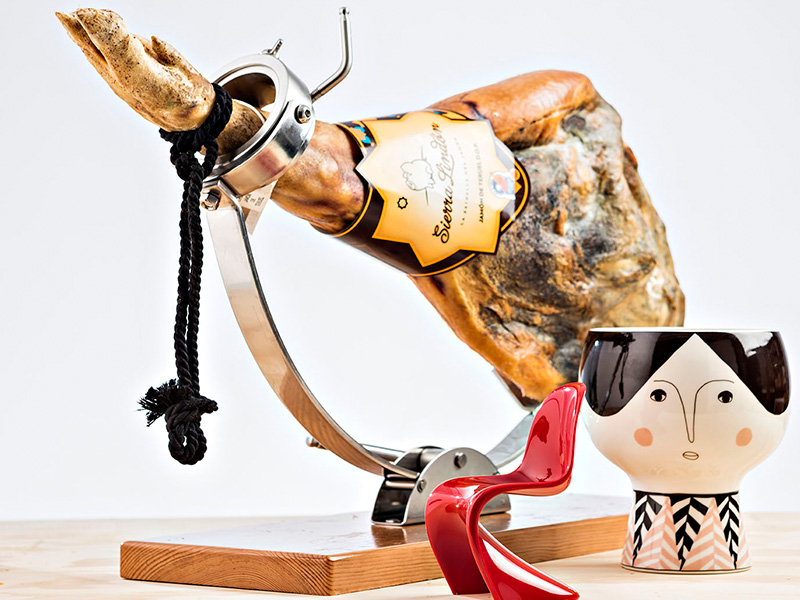
Ham, knives and of course, a ham stand. There’s nothing better to hold a leg of ham as you cut it than a good support or a ham stand. This tool is not only going to let you cut your piece so that you get the most out of it but it will also allow you to do it as safely as possible.
There are many models and prices on the market, from €15 to €800 approximately. The range is wide enough for you to find your ideal ham stand. Some people are a little taken aback that the support might cost them more than the actual ham, but there is a vast difference. While your ham will eventually be finished, your ham stand remains.
Just as when you are investing in other items such as a camera, there are models intended for professionals and models for amateurs. And just as few people would recommend a very low cost camera for an optimum result, nor would we recommend the lowest priced ham stands if you want to get the best out of your ham and avoid cutting yourself in the process. It is true that if you only eat ham from time to time and you only have a ham in the house at Christmas, a cheaper ham stand is better than cutting with no support at all. However, you’ll soon see that barely using it twice a year makes it worthwhile to invest a little more and fully enjoy your ham.
What does a professional cutter look for in a ham stand?
As we know more about making ham than cutting it, this time we have turned to Jorge Díaz Borreguero, professional cutter from the Art Dcorte Cutters Group, based in Galicia, to find out about the characteristics that he looks for in this work tool.
According to Jorge, one of the characteristics that he seeks “is that it is solid and with a good base so that it sits properly on the cutting table”. This is doubtlessly one of the main distinguishing features of a good quality ham stand. To cut slices in the best possible way, you have to pick a support that “practically does not move or moves as little as possible”. Among the professional models, we find several materials for bases. From marble to stainless steel, including wood, polyethylene fibre or Silestone, each one provides solidity and weight as well as design. However, for the sector’s professionals, who have to travel from one event to another and transport their tools, there are other features to consider. “It is also useful if it can be transported easily, as sometimes there are two or three events on the same day and you are loaded down carrying many things, and it all weighs you down, so light-weight materials are appreciated”, states Jorge.
However, if anything has revolutionised the world of ham stands, featuring on all professional supports, it is swinging arms and turning heads. A ham stand on which we can move the piece and find the exact position that we want without having to position the ham on it time and again, offers vast possibilities. The ham stand that Jorge uses is “easy to handle, with good swing to adapt to any height wherever you go, with a turning head that makes it easier for you to cut the thicker end of the ham and change to the part with the least lean meat and then cut the third side and finish off the ham very easily.” If, in addition to all this, it has good ergonomics, it will doubtlessly make life easier for the person who is going to spend at least an hour and a half working on the piece.
What should I buy for my home?
It is true that some of the features that we have mentioned (solid, light, turning head or swinging arm) that differentiate supports also make them more expensive. However, these are exactly the supports that we should seek out for our homes while adapting them to our budget.
There are very cheap supports that have some of these features. Although it is true that the quality of the materials for the base or the mechanism of the heads or arms will not be the same, you are bound to find a model that suits what you are looking for.
Our recommendation is to buy a ham stand that provides stability above all. Safety first, both for professionals and amateurs. If you don’t have either the knives or the skill of a professional cutter, you should at least have a ham stand that stops your ham shaking like a jelly. This does not so much mean a support to stab your ham, leaving it like a colander, but that the base is heavy, and the arm adjusts to it firmly. Regarding this aspect, Jorge Díaz adds: “For home, for amateurs, my opinion is that it can be a basic ham stand but if possible, without the classic spike on the tip to hold the piece”. Because any unnecessary “wound” that we inflict on the ham could lead to major problems in the future. When we spike the ham, air gets in and it begins to oxidise or if it has been there a long time, mould could get into a short-cured ham and ruin this entire part around the hole,” states Jorge. In addition, he continues, “there are simple ham stands with a swinging head, without having to look at premium ham stands, and they can be very useful for homes.”
Whichever ham stand you choose, consider that most of the responsibility for getting all the meat off the ham and safety when cutting it falls on the stand. Choose well.


